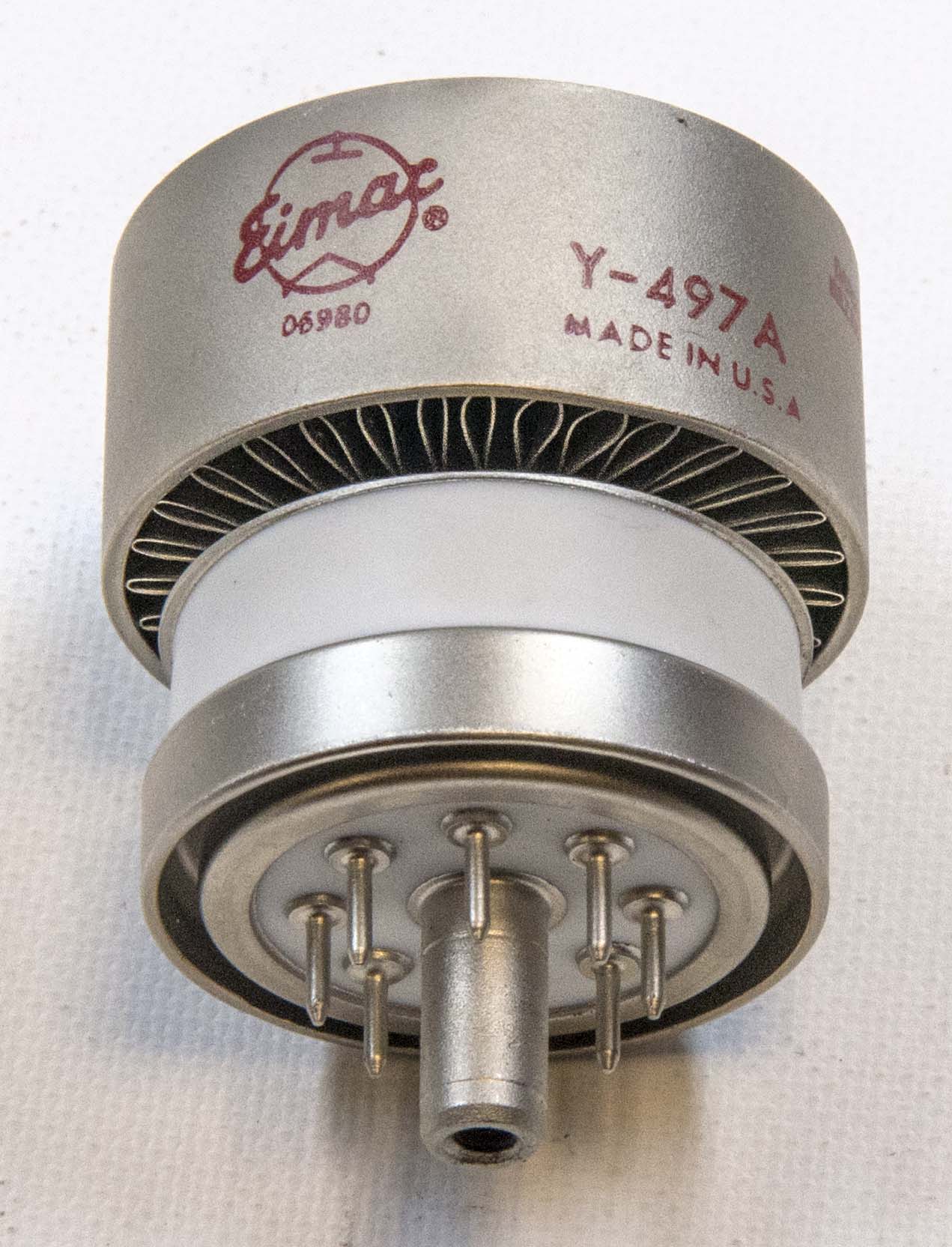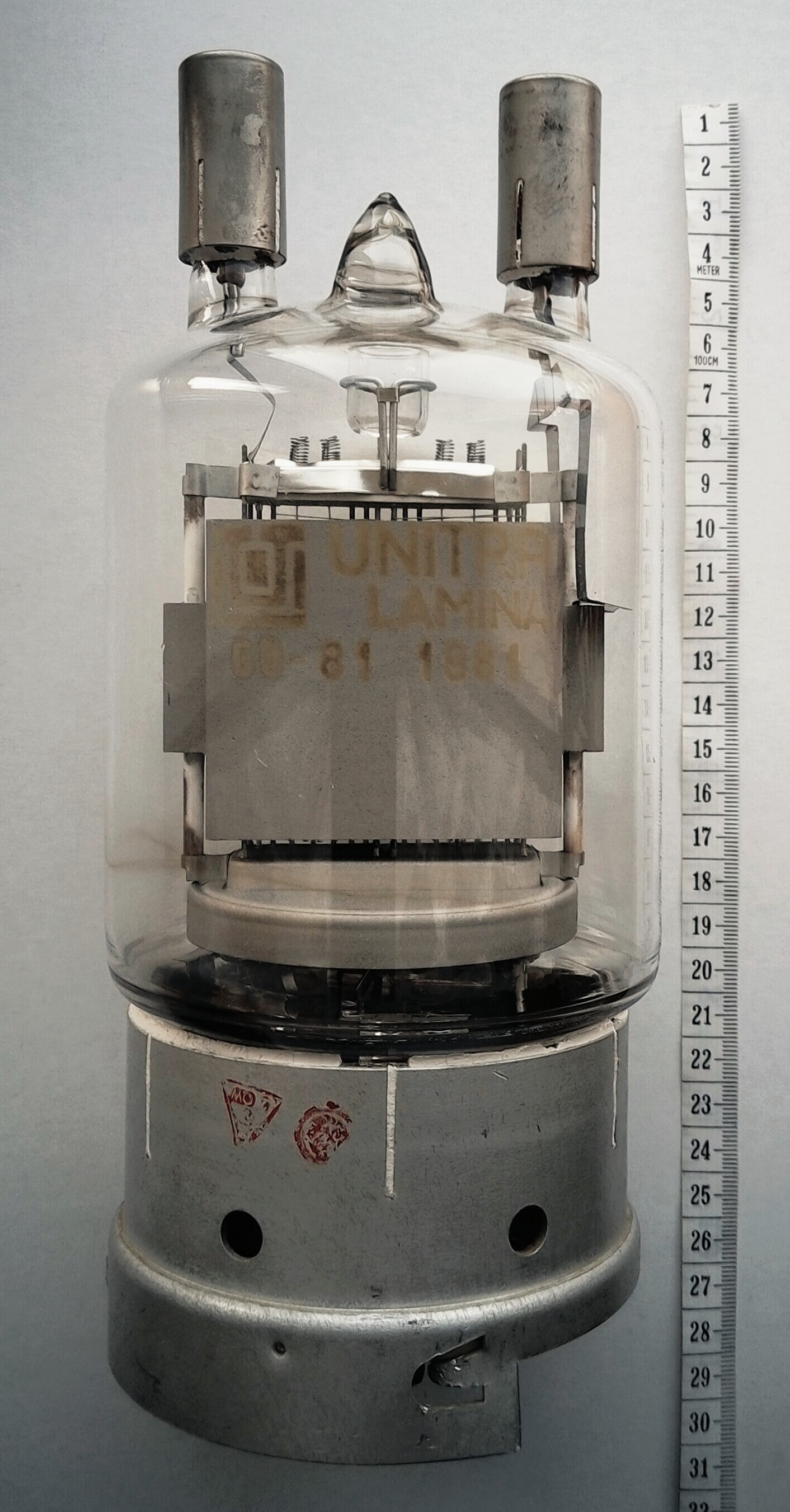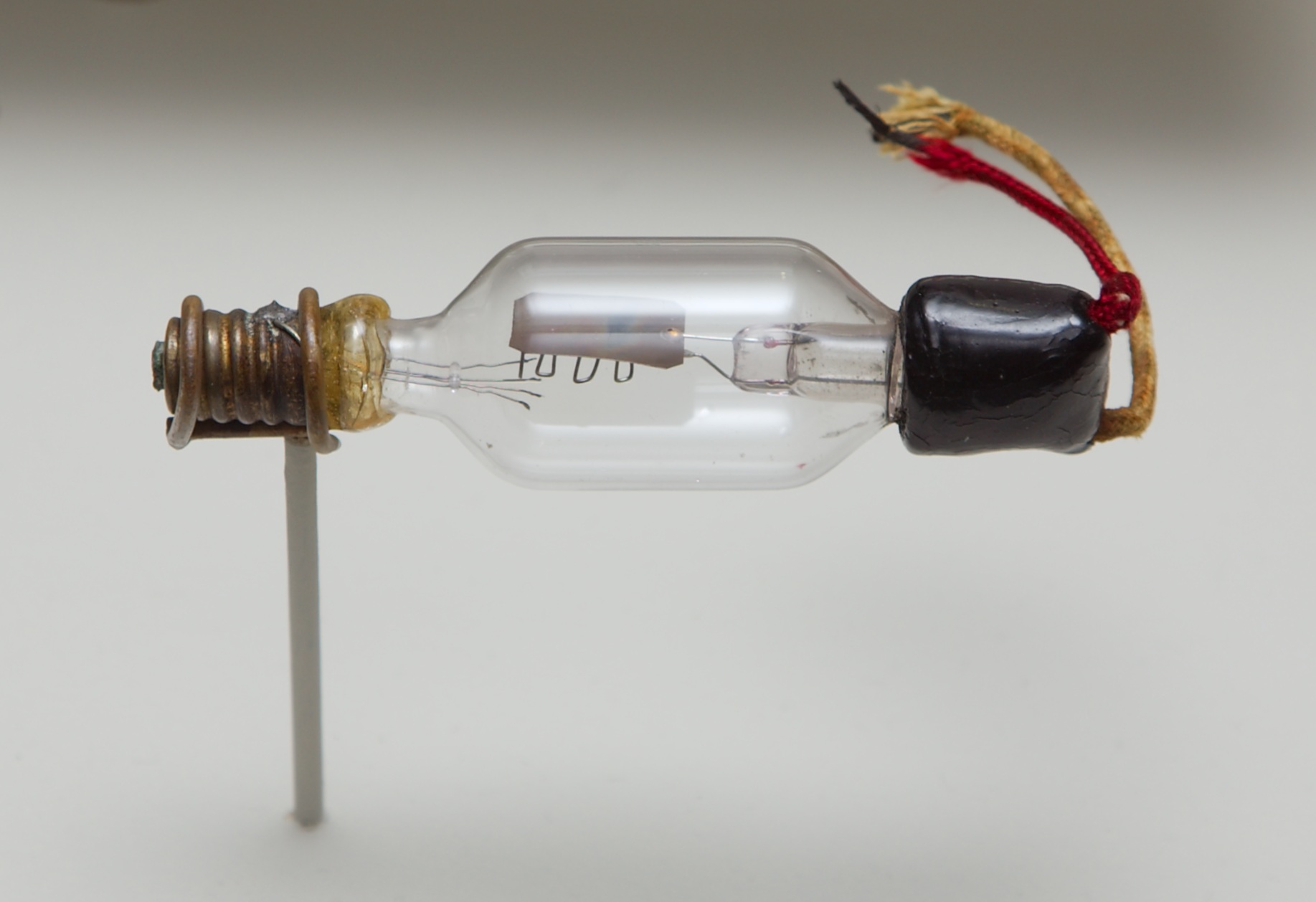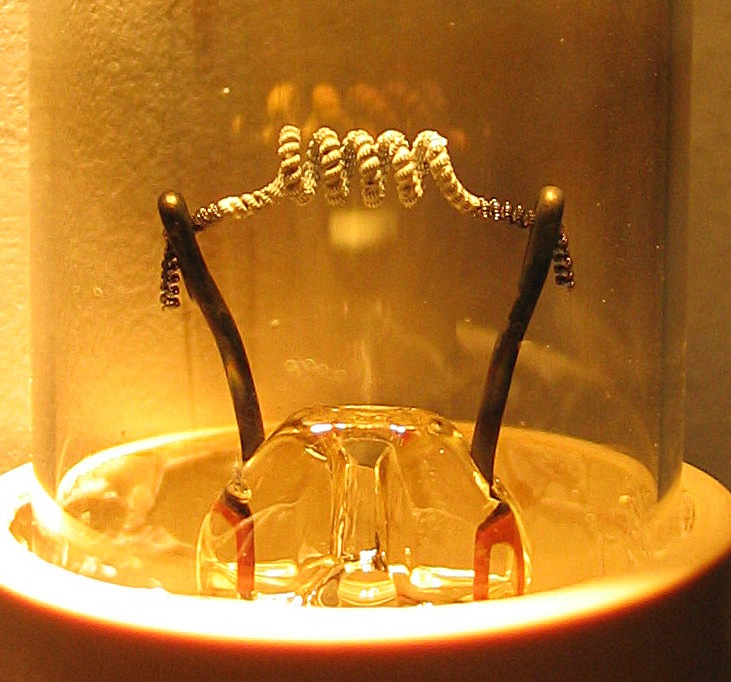|
Tetrode
A tetrode is a vacuum tube (called ''valve'' in British English) having four active electrodes. The four electrodes in order from the centre are: a thermionic cathode, first and second grids and a plate (called ''anode'' in British English). There are several varieties of tetrodes, the most common being the screen-grid tube and the beam tetrode. In screen-grid tubes and beam tetrodes, the first grid is the control grid and the second grid is the screen grid. In other tetrodes one of the grids is a control grid, while the other may have a variety of functions. The tetrode was developed in the 1920s by adding an additional grid to the first amplifying vacuum tube, the triode, to correct limitations of the triode. During the period 1913 to 1927, three distinct types of tetrode valves appeared. All had a normal control grid whose function was to act as a primary control for current passing through the tube, but they differed according to the intended function of the other gri ... [...More Info...] [...Related Items...] OR: [Wikipedia] [Google] [Baidu] |
Beam Tetrode
A beam tetrode, sometimes called a beam power tube, is a type of vacuum tube or thermionic valve that has two grids and forms the electron stream from the cathode into multiple partially collimated beams to produce a low potential space charge region between the anode and screen grid to return anode secondary emission electrons to the anode when the anode potential is less than that of the screen grid.Winfield G. Wagener, (May 1948"500-Mc. Transmitting Tetrode Design Considerations" ''Proceedings of the I.R.E.'', p. 612. Retrieved 10 June 2021 Beam tetrodes are usually used for power amplification, from audio frequency to radio frequency. The beam tetrode produces greater output power than a triode or pentode with the same anode supply voltage. The first beam tetrode marketed was the Marconi N40, introduced in 1935.Editors, (Feb. 1935"New Output Tetrode" ''Electronics'', vol. 8 no.2, p. 65. Retrieved 10 June 2021K. R. Thrower, (2009) ''British Radio Valves The Classic Years: ... [...More Info...] [...Related Items...] OR: [Wikipedia] [Google] [Baidu] |
Vacuum Tube
A vacuum tube, electron tube, valve (British usage), or tube (North America), is a device that controls electric current flow in a high vacuum between electrodes to which an electric voltage, potential difference has been applied. The type known as a thermionic tube or thermionic valve utilizes thermionic emission of electrons from a hot cathode for fundamental electronic functions such as signal amplifier, amplification and current rectifier, rectification. Non-thermionic types such as a vacuum phototube, however, achieve electron emission through the photoelectric effect, and are used for such purposes as the detection of light intensities. In both types, the electrons are accelerated from the cathode to the anode by the electric field in the tube. The simplest vacuum tube, the diode (i.e. Fleming valve), invented in 1904 by John Ambrose Fleming, contains only a heated electron-emitting cathode and an anode. Electrons can only flow in one direction through the device—fro ... [...More Info...] [...Related Items...] OR: [Wikipedia] [Google] [Baidu] |
Pentode
A pentode is an electronic device having five electrodes. The term most commonly applies to a three-grid amplifying vacuum tube or thermionic valve that was invented by Gilles Holst and Bernhard D.H. Tellegen in 1926. The pentode (called a ''triple-grid amplifier'' in some literature) was developed from the ''screen-grid tube'' or ''shield-grid tube'' (a type of tetrode tube) by the addition of a grid between the screen grid and the plate. The screen-grid tube was limited in performance as an amplifier due to secondary emission of electrons from the plate. The additional grid is called the ''suppressor grid''. The suppressor grid is usually operated at or near the potential of the cathode and prevents secondary emission electrons from the plate from reaching the screen grid. The addition of the suppressor grid permits much greater output signal amplitude to be obtained from the plate of the pentode in amplifier operation than from the plate of the screen-grid tube at the same plate ... [...More Info...] [...Related Items...] OR: [Wikipedia] [Google] [Baidu] |
Triode
A triode is an electronic amplifying vacuum tube (or ''valve'' in British English) consisting of three electrodes inside an evacuated glass envelope: a heated filament or cathode, a grid, and a plate (anode). Developed from Lee De Forest's 1906 Audion, a partial vacuum tube that added a grid electrode to the thermionic diode ( Fleming valve), the triode was the first practical electronic amplifier and the ancestor of other types of vacuum tubes such as the tetrode and pentode. Its invention founded the electronics age, making possible amplified radio technology and long-distance telephony. Triodes were widely used in consumer electronics devices such as radios and televisions until the 1970s, when transistors replaced them. Today, their main remaining use is in high-power RF amplifiers in radio transmitters and industrial RF heating devices. In recent years there has been a resurgence in demand for low power triodes due to renewed interest in tube-type audio systems by ... [...More Info...] [...Related Items...] OR: [Wikipedia] [Google] [Baidu] |
Control Grid
The control grid is an electrode used in amplifying thermionic valves (vacuum tubes) such as the triode, tetrode and pentode, used to control the flow of electrons from the cathode to the anode (plate) electrode. The control grid usually consists of a cylindrical screen or helix of fine wire surrounding the cathode, and is surrounded in turn by the anode. The control grid was invented by Lee De Forest, who in 1906 added a grid to the Fleming valve ( thermionic diode) to create the first amplifying vacuum tube, the Audion ( triode). Operation In a valve, the hot cathode emits negatively charged electrons, which are attracted to and captured by the anode, which is given a positive voltage by a power supply. The control grid between the cathode and anode functions as a "gate" to control the current of electrons reaching the anode. A more negative voltage on the grid will repel the electrons back toward the cathode so fewer get through to the anode. A less negative, o ... [...More Info...] [...Related Items...] OR: [Wikipedia] [Google] [Baidu] |
Cathode
A cathode is the electrode from which a conventional current leaves a polarized electrical device. This definition can be recalled by using the mnemonic ''CCD'' for ''Cathode Current Departs''. A conventional current describes the direction in which positive charges move. Electrons have a negative electrical charge, so the movement of electrons is opposite to that of the conventional current flow. Consequently, the mnemonic ''cathode current departs'' also means that electrons flow ''into'' the device's cathode from the external circuit. For example, the end of a household battery marked with a + (plus) is the cathode. The electrode through which conventional current flows the other way, into the device, is termed an anode. Charge flow Conventional current flows from cathode to anode outside the cell or device (with electrons moving in the opposite direction), regardless of the cell or device type and operating mode. Cathode polarity with respect to the anode can be posi ... [...More Info...] [...Related Items...] OR: [Wikipedia] [Google] [Baidu] |
Space Charge
Space charge is an interpretation of a collection of electric charges in which excess electric charge is treated as a continuum of charge distributed over a region of space (either a volume or an area) rather than distinct point-like charges. This model typically applies when charge carriers have been emitted from some region of a solid—the cloud of emitted carriers can form a space charge region if they are sufficiently spread out, or the charged atoms or molecules left behind in the solid can form a space charge region. Space charge only occurs in dielectric media (including vacuum) because in a conductive medium the charge tends to be rapidly neutralized or screened. The sign of the space charge can be either negative or positive. This situation is perhaps most familiar in the area near a metal object when it is heated to incandescence in a vacuum. This effect was first observed by Thomas Edison in light bulb filaments, where it is sometimes called the Edison effect. Space ... [...More Info...] [...Related Items...] OR: [Wikipedia] [Google] [Baidu] |
Plate Electrode
A plate, usually called anode in Britain, is a type of electrode that forms part of a vacuum tube. It is usually made of sheet metal, connected to a wire which passes through the glass envelope of the tube to a terminal in the base of the tube, where it is connected to the external circuit. The plate is given a positive potential, and its function is to attract and capture the electrons emitted by the cathode. Although it is sometimes a flat plate, it is more often in the shape of a cylinder or flat open-ended box surrounding the other electrodes. Construction The plate must dissipate heat created when the electrons hit it with a high velocity after being accelerated by the voltage between the plate and cathode. Most of the waste power used in a vacuum tube is dissipated as heat by the plate. In low power tubes it is usually given a black coating, and often has "fins" to help it radiate heat. In power vacuum tubes used in radio transmitters, it is often made of a refra ... [...More Info...] [...Related Items...] OR: [Wikipedia] [Google] [Baidu] |
Thermionic Cathode
In vacuum tubes and gas-filled tubes, a hot cathode or thermionic cathode is a cathode electrode which is heated to make it emit electrons due to thermionic emission. This is in contrast to a cold cathode, which does not have a heating element. The heating element is usually an electrical filament heated by a separate electric current passing through it. Hot cathodes typically achieve much higher power density than cold cathodes, emitting significantly more electrons from the same surface area. Cold cathodes rely on field electron emission or secondary electron emission from positive ion bombardment, and do not require heating. There are two types of hot cathode. In a ''directly heated cathode'', the filament is the cathode and emits the electrons. In an ''indirectly heated cathode'', the filament or ''heater'' heats a separate metal cathode electrode which emits the electrons. From the 1920s to the 1960s, a wide variety of electronic devices used hot-cathode vacuum tubes. ... [...More Info...] [...Related Items...] OR: [Wikipedia] [Google] [Baidu] |
Oscillator
Oscillation is the repetitive or Periodic function, periodic variation, typically in time, of some measure about a central value (often a point of Mechanical equilibrium, equilibrium) or between two or more different states. Familiar examples of oscillation include a swinging pendulum and alternating current. Oscillations can be used in physics to approximate complex interactions, such as those between atoms. Oscillations occur not only in mechanical systems but also in dynamic systems in virtually every area of science: for example the beating of the human heart (for circulation), business cycles in economics, predator–prey population cycles in ecology, geothermal geysers in geology, vibration of strings in guitar and other string instruments, periodic firing of nerve cells in the brain, and the periodic swelling of Cepheid variable stars in astronomy. The term ''vibration'' is precisely used to describe a mechanical oscillation. Oscillation, especially rapid oscillation, m ... [...More Info...] [...Related Items...] OR: [Wikipedia] [Google] [Baidu] |
Transconductance
Transconductance (for transfer conductance), also infrequently called mutual conductance, is the electrical characteristic relating the current through the output of a device to the voltage across the input of a device. Conductance is the reciprocal of resistance. Transadmittance (or transfer admittance) is the AC equivalent of transconductance. Definition Transconductance is very often denoted as a conductance, ''g''m, with a subscript, m, for ''mutual''. It is defined as follows: :g_m = \frac For small signal alternating current, the definition is simpler: :g_m = \frac The SI unit for transconductance is the siemens, with the symbol S, as in conductance. Transresistance Transresistance (for transfer resistance), also infrequently referred to as mutual resistance, is the dual of transconductance. It refers to the ratio between a change of the voltage at two output points and a related change of current through two input points, and is notated as ''r''m: :r_m = \fr ... [...More Info...] [...Related Items...] OR: [Wikipedia] [Google] [Baidu] |
Thorpe K4 Bi-Grid Valve
Thorpe is a variant of the Middle English word '' thorp'', meaning hamlet or small village. Thorpe may refer to: People * Thorpe (surname), including a list of people with the name Places England *Thorpe, Cumbria * Thorpe, Derbyshire *Thorpe, East Lindsey, Lincolnshire * Thorpe, East Riding of Yorkshire * Thorpe, North Yorkshire * Thorpe, Nottinghamshire * Thorpe, Surrey * Thorpe by Trusthorpe, Lincolnshire * Thorpe Hamlet, Norwich, Norfolk *Thorpe Hesley, South Yorkshire * Thorpe in Balne, South Yorkshire *Thorpe in the Fallows, Lincolnshire * Thorpe Latimer, Lincolnshire * Thorpe-le-Soken, Essex * Thorpe le Street, East Riding of Yorkshire * Thorpe on the Hill, Lincolnshire * Thorpe on the Hill, West Yorkshire * Thorpe St Andrew, Norfolk * Thorpe St Peter, Lincolnshire * Thorpe Tilney, Lincolnshire *Thorpe Waterville, Northamptonshire * Thorpe Willoughby, North Yorkshire Elsewhere * Thorpe, Missouri, a community in the United States See also * Littlethorpe, Leicestershire ... [...More Info...] [...Related Items...] OR: [Wikipedia] [Google] [Baidu] |






